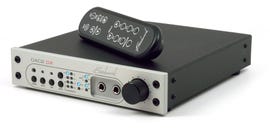For as long as I can remember audiophiles have struggled to find the best sounding digital connections. The CD debuted back in 1982 and computer audio is now fully entrenched, but even so, we still haven’t reached a consensus. Which connection/interface sounds best: USB, Toslink (aka optical), coaxial or AES/EBU (Audio Engineering Society/European Broadcasting Union)? I turned to the experts and asked them, what’s best and why?
Schiit Audio’s Mike Moffat was the first to respond, and he had plenty to say. Moffat started designing high-end digital converters way back in the ’80s at Theta Digital, so he’s grappled with the finer details of the audio arts longer than most.

The Benchmark DAC2 DX digital converter.
Benchmark
Moffat noted that coaxial and AES/EBU digital connections are well isolated with transformers in the best gear, but “capacitive leaks” reduce this advantage greatly at higher frequencies. AES/EBU is more suitable for longer cable runs than coaxial connections, and so it’s “less susceptible to common mode high frequency crap.” That’s why recording studios use AES/EBU digital cables.
He thinks USB uses the most complex processing to encode at the source and decode at playback, which causes him to look askance at that medium. Moffat concedes USB has greatly improved since it was introduced.
Getting back to the original question — which connection scheme sounds best — he said, “All I can do is make generalizations, which are very much system and grounding dependent.” He spelled out his preferences in the following order:
- AES-EBU has the best potential, but it’s rarely found in consumer gear.
- Coaxial.
- A tie between Toslink and USB (Moffat leans slightly in favor of USB).
I also heard from Meridian Audio’s founder, digital pioneer Bob Stuart. Again, Stuart has been working with digital since the early days, and he started with this, “You will have readers who disagree, and that’s fine. Everything makes a difference. Which is best? Well, that sort of depends on the DAC and the source (is it a server, PC or optical disc?) as well as the interface and even the digital interconnect cable. The better the rendering device (DAC), the smaller the difference.”


Toslink (left), coaxial (center), and USB (right) digital audio connectors.
Steve Guttenberg/CNET
He also said, “Of course digital bits-are-bits and with due care, each of the three interfaces (USB, Toslink, coaxial) can deliver the same data at approximately the same time. But the audio we hear is analog and real-world devices are subject to a variety of interferences including data-induced jitter, other process-induced jitter, (and) common- and differential-mode electromagnetic noise. In the ideal world, the data are clocked in by and buffered in the DAC (asynchronous mode) and then de-jittered before conversion. In my experience this can never be perfect, just made closer and closer to irrelevance.”
Other experts claimed optical connections are more jitter-prone than the other options. USB is the only format that uses “packetized” data streams; the others rely on continuous data streams. Confused? Sure, I don’t blame you. There are no perfect solutions, just different compromises.
Listening
I used my Oppo BD-105 Blu ray player hooked up to an Arcam irDAC digital converter and compared the sound of Toslink and coaxial connections. I used my Magnepan .7 speakers for all of my listening tests.
Starting with AudioQuest Carbon coaxial and AudioQuest Vodka Toslink digital cables, the difference was primarily in clarity. That is, the sound was less transparent and softer with the Toslink cable, and soundstage depth was reduced compared with that of the coaxial cable. The differences in sound quality between AudioQuest Toslink and coaxial cables running between the Oppo player and Arcam DAC were larger than I expected.
I also compared the AudioQuest Vodka Toslink and Carbon coaxial cables with generic, low cost cables. The AudioQuest Toslink cable decisively clobbered the generic cable — that one constricted and flattened the soundstage and smothered treble “air.” The AudioQuest Carbon coaxial cable bested the generic coaxial cable by sounding more vibrant and dynamically alive. The generic coaxial cable sounded rather bland by comparison.
So yes, everything changes the sound of digital audio: the source, the digital converter, the cables and the implementation of the interface connections. Your “mileage,” as they say, will vary. To find out what’s best in your system, you have to listen for yourself.




